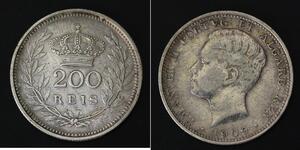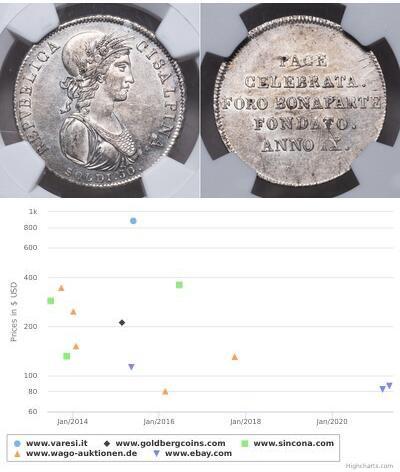(продана за $401.0)
1585, Saxony (Ernestine), Frederick William & John II. Silver Thaler Coin. XF!
Mint Year: 1585
Mint Place: Saalfeld
Denomination: Thaler
Reference: Koppe 33, Schnee 238, Davenport 9770. R!
Condition: Minor scratches in fields, otherwise XF (better than the picture!)
Weight: 29.10gm
Diameter: 42mm
Material: Silver
Obverse: Facing half-length bust of Duke Friedrich Wilhelm I. Six shields around splitting legend.
Legend: D:G.ERN-WIL.DV-SAX.LA-N.THV.F-MAR.MI-MO.IMI
Comment: Floral branches at armour bases.
Exergue: I59Z (typical date numberal style for early coinage, Z for 2, I for 1)
Reverse: Facing half-length bust of Duke Friedrich John II. Six shields around and a cross-topped-orb above splitting legend.
Legend: +IO-HAN.DV-SAX.IA-N.THVR-E.MAR-MIS.(privy mark)-D:G
Frederick Wilhelm I, Duke of Saxe-Weimar (b. Weimar, 25 April 1562 - d. Weimar, 7 July 1602), was a duke of Saxe-Weimar, and 11th Great Grandfather to Queen Elizabeth II. He was the eldest son of Johann Wilhelm, Duke of Saxe-Weimar and Dorothea Susanne of Simmern.
In 1586 Frederick Wilhelm was declared an adult and began his independent government over in Saxe-Weimar. Five years later, in 1591, the Elector Christian I of Saxony died and was succeeded by his eldest son Christian II. Because the new Elector was still under age, the regency of the Electorate was assigned to Frederick Wilhelm. With the title of Administrator des Sächsischen Kurstaates (Administrator of the Saxon Electorate) took residence in Torgau, and neglected the government of his duchy. These were led by his younger brother Johann, which had to be taken part -in accordance with the Ernestine House Law- anyway in the government.
In 1601 ended the regency in the Electorate of Saxony with the majority of Elector Christian II, and Frederick Wilhelm returned to Weimar. Since he however already died one year later, he not left large traces in the history of the duchy.
John II, Duke of Saxe-Weimar (Johann Maria Wilhelm) (b. Weimar, 22 May 1570 - d. Weimar, 18 July 1605), was a Duke of Saxe-Weimar and Jena.
He was the second son of Johann Wilhelm, Duke of Saxe-Weimar and Dorothea Susanne of Simmern.
His father died in 1573, when Johann was only three years old. Since at the time his older brother Frederick Wilhelm I was also under age, the duchy of Saxe-Weimar (originally appointed to Johann) was governed by a regency. In 1586 his older brother reached adulthood and took full control of the duchy, including Weimar. However, he died in 1602 and the full duchy was inherited by Johann, because his nephews (the sons of his deceased brother) were under age.
Johann was more interested in natural sciences and art than politics, and therefore only against his will took over the regency of the duchy on behalf of his nephews. But when they demanded their own inheritance in 1603, he resisted their demands. Finally, Johann and his nephews made a treaty dividing the duchy: Altenburg was taken by the sons of Frederick Wilhelm I, and Weimar-Jena was retained by Johann.
This line of Saxe-Altenburg became extinct in 1672, and all the inheritance passed by marriage to the line of Saxe-Weimar, the descendants of Johann.

|
Добавив:
anonymous 2016-08-12 |
200 Рейс Королівство Португалія (1139-1910) Срібло Мануэл II ...
в групі 6 монет / 5 цін
⇑

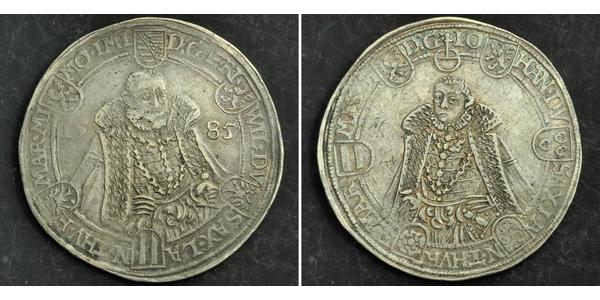






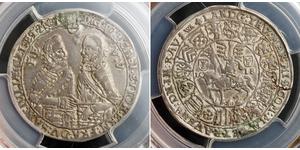
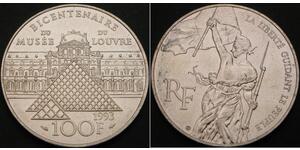





-300-150-GebBwcI0fjYAAAEqreNDRaTs.jpg)
